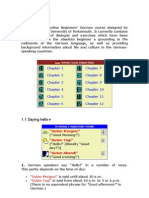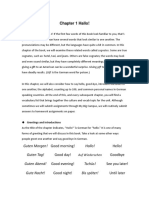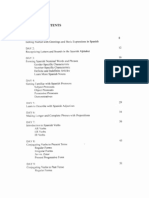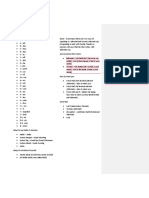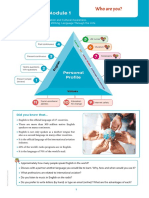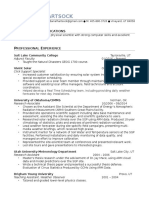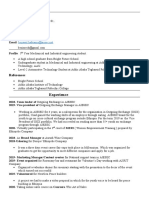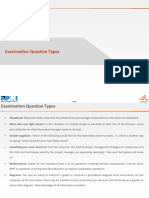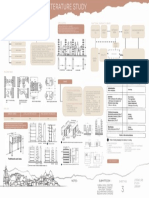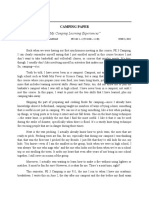German lesson 1: How to greet people
1. GREETINGS In German, the word you will often hear to say Hi or Hello to someone is Hallo. It is clearly similar to the English greeting, and just like hello it is always used to greet peers, such as classmates, or people you know very well, like relatives and friends. In other words, this is an informal greeting. Formal greetings are instead more indicated when you are saying hello to a person you meet for the first time, as well as older people or someone in authority, for example a doctor, a teacher, a police officer. So, you say: - Guten Morgen until about noon; then, until 5 pm, the correct form is Guten Tag (both expressions correspond to Good morning). - In the evening you use Guten Abend for Good evening. - At night you finally say Gute Nacht. In general, if you want to say goodbye to someone, you can use Tschss, which is more informal, or Auf Wiedersehen, which is its formal equivalent. Auf Wiedersehen literally means see you again. To sum up, here is a short recap of all German greetings. YOU ARE GREETING A FRIEND: Hallo (Hi, Hello) - Tschss (Bye) - Gute Nacht (Good night) A STRANGER: Guten Morgen (until 12 am) - Guten Tag (until 5 pm) - Guten Abend (Good evening) - Auf Wiedersehen (See you) - Gute Nacht (Good night)
2. TALKING ON THE PHONE
When you answer the phone, you can greet people using the expressions above. While, if you want to end a conversation on the phone, you say Auf Wiederhren, which literally means hear you again. Some other useful expressions to say goodbye to your interlocutor are: - Bis dann! or Bis spter! or Bis nachher! See you later! - Bis bald! See you soon! - Bis morgen! See you tomorrow! German language, like many other languages, has different forms for addressing people
�you are close to and people with whom you dont have an informal relationship, or whom you get to know in a more formal context, like at work. Therefore, when asking How are you? in German, it's essential to consider who is your interlocutor. - Wie geht es dir?, which is usually shortened in Wie gehts? is used with friends, relatives and peers - Wie geht es Ihnen? is used with strangers, older people, authorities. On the contrary, if you are asked Wie geht es dir? or Wie geht es Ihnen? the answer can be: means I am fine. You can obviously say just Gut. I feel quite good I feel very good Im not very well I feel bad So-so, if youre feeling neither good nor bad
In German Mir geht es gut Mir geht es ganz gut Mir geht es sehr gut Mir geht es schlecht or Mir geht es sehr schlecht Es geht so
Here are two short dialogues to resume the previous expressions. A: Hallo, wie geht es dir? Hello, how are you? B: Mir geht es gut, und dir? Im fine and you? A: Mir geht es auch gut, danke! Im fine too, thank you! This is the informal version. The formal one would be: A: Guten Tag, wie geht es Ihnen? Good morning, how are you? B: Mir geht es gut, und Ihnen? I am fine and you? A: Danke, mir geht es auch gut! I am fine too, thanks.
�German Lesson 2: How to introduce yourself and ask where someone's from
Introducing yourself After asking someone how he/she is, you generally want to know something more about him/her, for example where he/she comes from. How are you? is translated by Wie geht es dir? when talking to a friend or peer, and by Wie geht es Ihnen? if your interlocutor is a stranger or an authority. (see lesson 1) The same distinction is made when you ask Where are you from? Woher kommst du? or Wo kommst du her? are used in informal contexts Woher kommen Sie? or Wo kommen Sie her? are used in formal contexts A possible answer to this question would be: Ich komme aus Mnchen I come from Munich. You could also answer: Ich wohne in Mnchen or Ich lebe in Mnchen I live in Munich. So...
?QUESTION? Woher kommst du? / Wo kommst du her? Woher kommen Sie? / Wo kommen Sie her? !ANSWER! Ich komme aus... Ich wohne / lebe in...
Its interesting to know where somebody is from, but its even more important to ask for his/her name and to introduce yourself. To ask for someones name in German you say: Wie heit du? This is the informal expression, while the formal one is Wie heien Sie? The answer to both questions is the same: Ich heie ... My name is ... You could also say Ich bin ... I am As an alternative, you can ask: Wie ist dein Name? (informal) or Wie ist Ihr Name? (formal) These are the literal translations of Whats your name? to which you will answer: Mein Name ist ... My name is
�To sum up: Informal question Formal question Answer
Where are you from?
Woher kommst Woher du? kommen Sie? Wo kommst du Wo kommen her? Sie her?
Ich komme aus Ich wohne in Ich lebe in
I come from
I live in
Whats your name?
Wie heit du? Wie heien Sie? Ich heie... Ich bin... Mein Name ist...
My name is... I am...
Wie ist dein Name?
Wie ist Ihr Name?
The whole conversation could be like this: A: Guten Tag, wie geht es dir? - Good morning, how are you? B: Es geht so, und dir? - So-so and you? A: Mir geht es gut. - Im fine B: Wie heit du? - What's your name? A: Ich heie Sandra, und du? - I'm Sandra and you? B: Mein Name ist Frauke - My name is Frauke A: Woher kommst du? - Where are you from? B: Ich komme aus Frankfurt und du? - I come from Frankfurt and you? A: Ich komme aus Berlin - I come from Berlin B: Tschss - Bye A: Tschss - Bye This is obviously an example of an informal conversation with a person you have just met in an informal context. It could be a dialogue between children, teens or young adults. From a certain age on you wont use the informal register with people you have just met.
�German Lesson 3: the German alphabet
Why learn German? If youre still wondering if its worth learning German, perhaps you will find it interesting that in Germany there are 82 million people, not to mention the Austrians and the Swiss. Indeed, German is the language with the largest amount of native speakers in Europe, and yet Germany is not that big and its actually one of the most densely populated country in Europe. Nevertheless, one third of its area is forest-covered, so you can find both beautiful countryside and large, densely populated cities bursting with life.
The German alphabet The grammatical subject of this third German lesson is the German alphabet, which is made up of 26 letters. There are 4 additional letters when writing in German, but they are not included in the alphabet. These letters are: whose pronunciation is similar to the diphthong in the English word head. An example of a German word with this sound is Gste guests you can found a similar sound in the English word blur. An example: Hren hear its sound doesnt exist in English. An example: Tr door it sounds like a sharp s as in list. An example: gro big The letters of the German alphabet are the same as the English one, what changes is only their pronunciation. Here is the alphabet, with each letter followed by an example of a word starting with it. A Affe B Br C Chamleon D Dose E Engel F Fu G Gast H Hund
�I Insel J Jger K Kind L Liebe M Maus N Nuss O Onkel P Papa Q Qualle R Rose S Sonne T Tal U Uhr V Vase W Waage X Xylophon Y Yak Z Zebra Nevertheless, German pronunciation is not as easy as it might seem, because it changes according to words. This lesson should just show you how to pronounce a single letter, thats to say a letter which is not in his natural context, the word. Anyway, in the following lessons each letter will be considered step by step.










